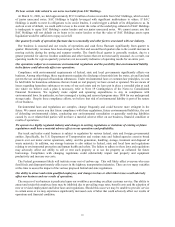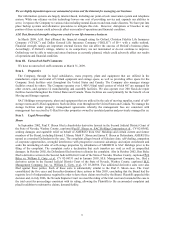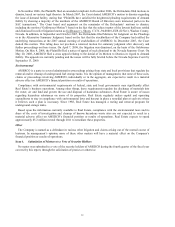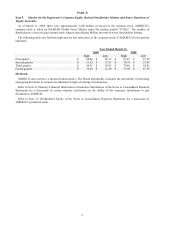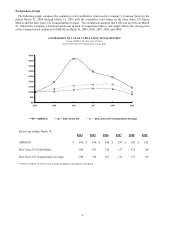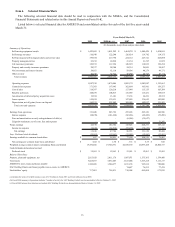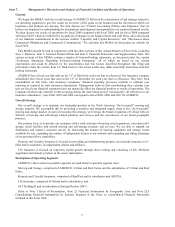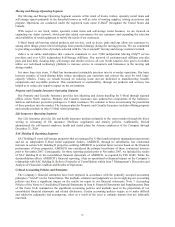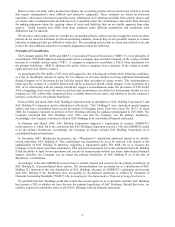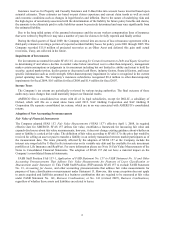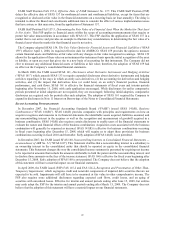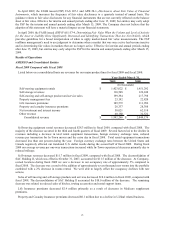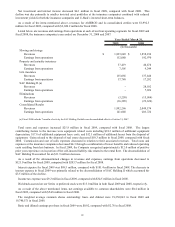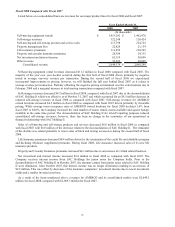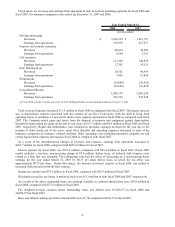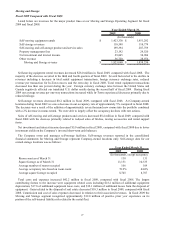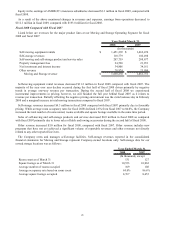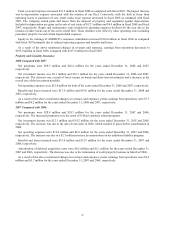U-Haul 2009 Annual Report Download - page 23
Download and view the complete annual report
Please find page 23 of the 2009 U-Haul annual report below. You can navigate through the pages in the report by either clicking on the pages listed below, or by using the keyword search tool below to find specific information within the annual report. 19
Below we have set forth, with a detailed description, the accounting policies that we deem most critical to us and
that require management’s most difficult and subjective judgments. These estimates are based on historical
experience, observance of trends in particular areas, information and valuations available from outside sources and
on various other assumptions that are believed to be reasonable under the circumstances and which form the basis
for making judgments about the carrying values of assets and liabilities that are not readily apparent from other
sources. Actual amounts may differ from these estimates under different assumptions and conditions; such
differences may be material.
We also have other policies that we consider key accounting policies, such as revenue recognition; however, these
policies do not meet the definition of critical accounting estimates, because they do not generally require us to make
estimates or judgments that are difficult or subjective. The accounting policies that we deem most critical to us, and
involve the most difficult, subjective or complex judgments include the following:
Principles of Consolidation
The Company applies FIN 46(R) and ARB 51, Consolidated Financial Statements (“ARB 51”), in its principles of
consolidation. FIN 46(R) addresses arrangements where a company does not hold a majority of the voting or similar
interests of a variable interest entity (“VIE”). A company is required to consolidate a VIE if it has determined it is
the primary beneficiary. ARB 51 addresses the policy when a company owns a majority of the voting or similar
rights and exercises effective control.
As promulgated by FIN 46(R), a VIE is not self-supportive due to having one or both of the following conditions:
a) it has an insufficient amount of equity for it to finance its activities without receiving additional subordinated
financial support or b) its owners do not hold the typical risks and rights of equity owners. This determination is
made upon the creation of a variable interest and can be re-assessed should certain changes in the operations of a
VIE, or its relationship with the primary beneficiary trigger a reconsideration under the provisions of FIN 46(R).
After a triggering event occurs the most recent facts and circumstances are utilized in determining whether or not a
company is a VIE, which other company(s) have a variable interest in the entity, and whether or not the company’s
interest is such that it is the primary beneficiary.
In fiscal 2003 and fiscal 2002, SAC Holding Corporation and its subsidiaries (“SAC Holding Corporation”) and
SAC Holding II Corporation and its subsidiaries (collectively, “SAC Holdings”) were considered special purpose
entities and were consolidated based on the provisions of Emerging Issues Task Force Issue No. 90-15. In fiscal
2004, the Company evaluated its interests in SAC Holdings utilizing the guidance promulgated in FIN 46(R). The
Company concluded that SAC Holdings were VIE’s and that the Company was the primary beneficiary.
Accordingly, the Company continued to include SAC Holdings in its consolidated financial statements.
In February and March 2004, SAC Holding Corporation triggered a requirement to reassess AMERCO’s
involvement in it, which led to the conclusion that SAC Holding Corporation was not a VIE and AMERCO ceased
to be the primary beneficiary. Accordingly, the Company no longer includes SAC Holding Corporation in its
consolidated financial statements.
In November 2007, Blackwater Investments, Inc. (“Blackwater”) contributed additional capital to its wholly-
owned subsidiary, SAC Holding II. This contribution was determined by us to be material with respect to the
capitalization of SAC Holding II; therefore, triggering a requirement under FIN 46(R) for us to reassess the
Company’s involvement with those subsidiaries. This required reassessment led to the conclusion that SAC Holding
II had the ability to fund its own operations and execute its business plan without any future subordinated financial
support; therefore, the Company was no longer the primary beneficiary of SAC Holding II as of the date of
Blackwater’s contribution.
Accordingly, at the date AMERCO ceased to have a variable interest and ceased to be the primary beneficiary of
SAC Holding II, it deconsolidated those entities. The deconsolidation was accounted for as a distribution of SAC
Holding II’s interests to the sole shareholder of SAC Holdings. Because of AMERCO’s continuing involvement
with SAC Holding II the distribution does not qualify as discontinued operations as defined by Statement of
Financial Accounting Standards (“SFAS”) 144, Accounting for the Impairment or Disposal of Long-Lived Assets.
It is possible that SAC Holdings could take actions that would require us to re-determine whether SAC Holdings
has become a VIE or whether we have become the primary beneficiary of SAC Holdings. Should this occur, we
could be required to consolidate some or all of SAC Holdings with our financial statements.



